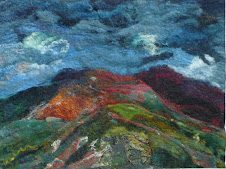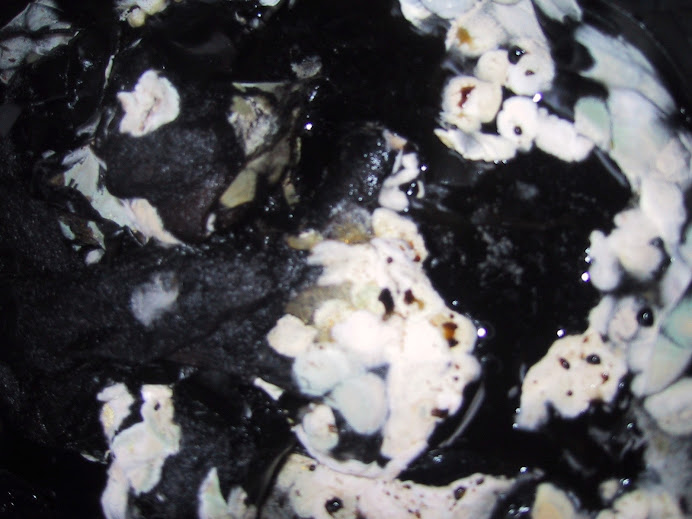



I have just had a lovely session dyeing silk fabrics and silk bricks in extract dyes. This is partly in preparation for the Wool Fest and partly because I just want to make some fabric lengths in naturally dyed silk and 18.5 merino. I am not sure to what end but something inside me urges me on and I have learnt to follow these urges as they usually lead me to something exciting.
I also have a number of solar dyeing experiments going on too! I recently got India Flint's fabulous book on eco dyeing whic has got me experimenting with variations on her techniques of bundling and rolling fabrics in dyes. I have two jars layered with silk caps and yarns with dyes like red cabbage, dyers camomile ( dried from last year) chopped madder root, dyers coreopsis black violas and some of the maize which gives purple. The jars alternate between the hot plates in the studio when it is cold and solar dyeing when like today it is warm and sunny. They have been on the go for about two weeks, the jar in the top picture is just a couple of days after starting and the picture of the two jars was taken today. I notice that the bottom of one jar looks quite pink, but I don't know what is giving that. The colours are deepening but not as such as I expected, I wonder whether it is because there is a lot of silk there which is quite dense. One of the jars contains 2 metres of silk chiffon crushed into the top. Lying flat on the slate is the one that looks the least interesting but shows signs of being the most exciting as it 2 metres of satin chiffon layered with red cabbage, madder roots, black violas and dyers camomile and more. I dyed a lot with red cabbage leaves when I came back from Colour Congress in 2002 and experimented with this technique of crushing dyes into fabrics and found that red cabbage gives blue which dyed like this appear to have a good lightfastness at least the fabrics I did 6 yrears ago show no sign of fading although I have not done precise lightfastnss tests. Over the last few weeks I have been trampling the pack and now the silk shows areas of a deep deep blue going to turquoise. I feel very excited about this but once it is washed and steamed ironed to fix the colors in they may not be so vibrant as they seem at the moment . It is hard to wait though!
Right at the back in a demijohn is some wool solar dyeing in madder and looking very red.
Incidentally for anyone reading this who has limited space this is a brilliant way to dye. A sunny balcony or windowsill is all you need as the silk is mordanted cold. ( Wet out the silk overnight make up a solution of alum as 35% dry weight of silk in alum, dissove in hot water, add to a bucket of water,stir, add the silk and leave for 12 hours. hey presto done). I found this recipe in Dominique Cardons book Natural Dyes. Then you could wrap the silk in red cabbage leaves, onion skins , eucalpytus leaves- India.Flint says that you can get e.cinerea from florists.
I decided to do some workshops in these techniques too as I am enjoying myself so much and I want to earn some money too, so I am having three ; one on Solar Dyeing and bundling fabrics with dyes on July 12th, one on extract dyeing on July 26th and one on dyeing the blues using the chinese woad, japanese polygonum, and woad as well as indigo on August 23rd so if anyone is interested all the info is on the website.
In the meantime I have lost something. I buried a metre of mordanted muslin in my compost heap ready to show S4C, now I can't find it. Any ideas on how to hunt for some missing fabric!



























Very timely, Helen. :) Actually I have some silk. Perhaps that would be the way to go for my first solar dyeing experiments(?) Your workshops sound excellent!
ReplyDeleteHi Leigh Ima glad that my workshops sound excellent ! Very encourging.
ReplyDeleteI find that silk is the certainly the best if you are bundling fabrics up with dye plants- and for these you can use red cabbage & onion skins to very good effect if nothing else is available but leaves of trees can be good. Eucalyptus,and birch but elder and oak might give you interesting effects although I ahven't tried them I have used cotton but the colour takes along long time to seep through the fabic. Solar dyeing in pots is easier and yarns are very nice as you get some lovely randon effects. I hope your experiments go well for you. bw Helen
I've just got the India Flint book too. Isn't it a beautiful book. Have you tried our common form of eucalyptus in this country? I'm eyeing up the neighbour's overhanging tree just now. Thanks for the tips on red cabbage. I've got a hot south facing bay window which I think is going to end up littered with jars.
ReplyDeleteSee you at Woolfest.
Hi Fi if you scroll right down to the bottom of the blog you will see the black that I got with my eucalyptus tree leaves last year. Someone has given me load of leaves form which I got yellow and a nice green with iron this year but it is much earlier in the eyar and the depth of colour will probably get better as time goes on. India told me that you can get E. Cinerea which gives red from florist . Look forward to meeting you at the Woolfest.
ReplyDeleteHello,
ReplyDeletethank you for this idea! it sounds great and it IS a good option for small space appartments !
Victoria